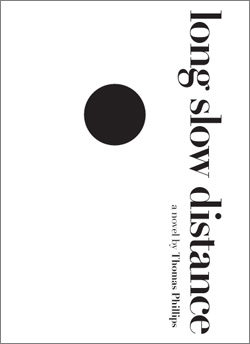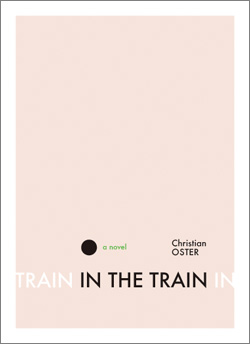Presses
Object Press: An Interview with Richard di Santo


I discovered Object Press via this entry on Chad Post’s Three Percent blog, and Post’s enthusiasm for the press and its latest book, a reprint of Christian Oster’s In The Train, convinced me to contact Richard di Santo, the founder. He sent me review copies of the two books he’s published so far and agreed to answer a few questions by email, which you can read below this introduction.
Object Press was founded in 2008 in Toronto and seeks
to present fiction—focusing on, but not limited to, the novel—that is somehow different, expanding its potential, its horizon of possibility. One aspect of this is reflected in presenting titles of relatively short length, favoring writing that is precise, inspired and thoughtfully structured. Another important motivation for us is something we don’t hear very much of in publishing, and that is the pursuit of joy. The joy of writing, reading; of discovering a new narrative, a new voice; of holding and handling books; of seeing them on shelves, inviting them into our lives, our thoughts. These books are objects for use, objects for reflection. And these are our projects, focusing on literary innovation, good design and the pleasures of literature.
The books that Object Press has published, Oster’s In The Train and Long Slow Distance by Thomas Phillips, successfully combine, I think, the two aspects described in the quote above. Both are short and can be read in one sitting–should be read in one sitting, perhaps–and both are quietly funny. Their structures, however, are quite different. Long Slow Distance gathers thirteen seemingly unrelated sections/characters together while In The Train moves solidly forward, following the actions of two reserved travelers. Both books seem to consider the careful ways humans situate themselves among others even as they preserve their own isolation. Phillips describes this best, saying in an interview that the novel seems focused on “the notion of becoming, an ongoing process to which we are all subject in different ways…there’s always a potentiality beyond the confines of conventional ways of being in the world, with people, with oneself in isolation. That potential is very compelling to me.”
I really enjoyed reading both of these books, and I join Post in wanting to recommend them to everyone; I hope to write up longer reviews at some point. Anyhow, please give them a read (you can read PDF excerpts at each book’s official web page) and support Object Press. I look forward to seeing what Object Press will publish next. Thank you to Richard di Santo for answering my questions.
HTMLGIANT: So, my first question is this: what led to your founding Object Press? Can you specifically address the ten years between your graduating from the University of Toronto with a degree in Literary Studies and Philosophy and your decision to start publishing?
Richard di Santo: I had a desire to establish a publishing house for years before actually doing it. While my education reflects my interest in writing and ideas, it had little bearing on my decision. I wasn’t motivated to continue with academic work, and wanted to move on to something more personal. I wanted to establish an ongoing project that would exist entirely on my own terms. And, given my interest in fiction, it wasn’t long before I knew what this project would be: a literary press with its own vision, editorial program, its own way of doing things. And while these ideas changed and became more focused through the years (during which I had been involved in other projects and jobs), the press has always been imagined primarily as a way of realizing and sharing works that I feel passionate about and find inspiring.
How I came to choose that particular moment to found Object Press was an answer to the question “If not now, when?” So, rather than continue to wait for the perfect set of circumstances, I started with two manuscripts in mind and decided to take it from there. I then discovered that it was, in fact, the perfect moment to do so.
In setting up a press that followed its own unique editorial program, did you look to other small presses for ideas? I’m thinking in particular of Dalkey Archive Press, with which I think Object Press seems to share some, superficial at least, qualities. How did the ideas change, as you say, during your involvement with other projects?
I haven’t looked directly to other presses for ideas or inspiration, but of course inspiration is all around; even from record labels, or any small operation with a clear focus and strong ideas. Dalkey Archive is certainly a wonderful press, but I didn’t specifically look to them as a model. Their list has expanded in remarkable ways, and the idea for Object Press is a little more modest. When it comes to molding the identity of the press, it’s less about existing models and direct inspirations, and more about attempting something of its own. The works we publish are the inspiration more than any publisher I can think of. But I do find myself asking questions like “What would my ideal publishing list look like?” and then go about trying to make it happen.
The ideas for the press changed, evolved, or became more refined, alongside my personal and literary interests. The two are very much connected. Our first two books offer a glimpse of where these interests lie.
Let’s talk about the books you’ve published: if the press came out of your already having manuscripts in mind, how did you acquire them? Tell us about that process, if you don’t mind? Specifically, what inspired you to republish Oster’s In The Train eight years after its publication in France, and how did you first come across Thomas Phillips’s manuscript?
I had met Thomas Phillips in Montreal a number of years ago. At the time, it was in connection with his work as a composer – in broad terms, his work falls within the area of electronic minimalism, or microsound. As our correspondence continued, I learned that he was also a writer. When I read Long Slow Distance, I was immediately won over by its challenging balance of story and style, its odd narratives that connect in unexpected ways. I held on to that manuscript, and it quickly became a part of the plans to get Object Press off the ground.
Christian Oster is an writer I have been following for a few years, and publishing In the Train is something of a dream project for me. We looked at a few different titles, and this one stood out immediately as the one we most wanted to work on. From there it was simply a matter of acquiring the rights. We also received gracious support from the French Consulate here in Toronto, and a French cultural organization called the National Center for the Book. As for the work itself, it’s such a unique novel, with humor, insight, and vulnerability, with an original narrative voice and pacing that turn what could have been a simple love story into something infinitely more compelling. Adriana Hunter, who translated In The Train for us, did a masterful job of getting the tone and rhythm just right. I couldn’t be happier with the results.
In your interviews with Oster and Phillips, they suggest a number of other names with whose work they identify or align their own, Toussaint’s, perhaps, being the most recognizable to HTMLGIANT readers. I assume that you are familiar with most, if not all of these other authors? This might be an overly simple question, but where can interested American readers find information on these sorts of authors? For example, you said you had been following Oster’s work for some time, but how did you first find his writing? I’m sorry if this is a weird question. I guess I’m asking this: what specific resources do you consult to find work by authors in whose writing you’re interested?
It’s not a strange question at all. But tracing how readers can find out about authors can be tricky business, and it’s really been no different for me as a publisher. Sometimes, it’s because you’ve read a review, looked at a publisher’s catalog, or read an interview (much like the ones you’ve mentioned) where an author might draw some connections with other writers, which piques your interest. Sometimes, it’s a friend or colleague making a recommendation. At others, it could be a more scholarly piece that points you in one direction (Warren Motte has written two books on contemporary French literature, for example). And sometimes, it’s just luck. Liking the cover, for example, or reading the first page and saying “ah.” I had heard of Oster as a writer connected with the French publishing house Les Éditions de Minuit, but had never read him until accidentally coming upon one of his books in translation, at a used bookshop. It happens like that, sometimes. It’s rarely in the form of, “You liked that, so you might like this.” You just find yourself making connections, drawing lines, and running threads through the books and authors you find most compelling. Sometimes, you find there are solid reasons for making those connections, and at others it feels quite random, but resonates just as clearly.
So, to try and answer your question about where readers might find information about the writers we at Object Press find ourselves drawn to, there are a number of places. Chad Post’s Three Percent blog is wonderful spot that focuses its coverage on works in translation. The Quarterly Conversation continues to publish thoughtful, focused reviews. Publications like Rain Taxi and Bookforum, for example, offer compelling coverage, and they openly support small, independent presses. And then there are the publishers themselves. Along with booksellers and libraries. My best advice would be to simply keep your eyes and ears open. Be curious about authors you haven’t heard of, talk with friends about what you’ve been reading, visit blogs and bookshops, literary events, ask questions, and take your time. It’s all out there.
Tags: Chad Post, Christian Oster, Object Press, Richard di Santo, Thomas Phillips, Three Percent

Congratulations Richard, on achieving your dream. Someone from highschool.
Richard, good for you!
Dorit